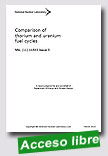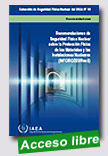 |

 |
 |
Comparison of thorium and uranium fuel cycles
National Nuclear Laboratory (UK), March 2012, 31 p.
The UK National Nuclear Laboratory has been contracted by the Department for Energy and Climate Change (DECC) to review and assess the relevance to the UK of the advanced reactor systems currently being developed internationally. Part of the task specification relates to comparison of the thorium and uranium fuel cycles. Worldwide, there has for a long time been a sustained interest in the thorium fuel cycle and presently there are several major research initiatives which are either focused
|
specifically on the thorium fuel cycle or on systems which use thorium as the fertile seed instead of U-238. Currently in the UK, the thorium fuel cycle is not an option that is being pursued commercially and it is important for DECC to understand why this is the case and whether there is a valid argument for adopting a different position in the future.
Extraído de:
http://www.decc.gov.uk/assets/decc/11/meeting-energy-demand/nuclear/6300-comparison-fuel-cycles.pdf
|
 |
 |
Country Nuclear Power Profiles - 2012 Edition
IAEA, 2012, s. p.
The Country Nuclear Power Profiles compile background information on the status and development of nuclear power programmes in Member States. The CNPP summarizes organizational and industrial aspects of nuclear power programs and provides information about the relevant legislative, regulatory, and international framework in each country. Its descriptive and statistical overview of the overall economic, energy, and electricity situation in each country and its
|
nuclear power framework is intended to serve as an integrated source of key background information about nuclear power programs in the world. This 2012 edition, issued on CD-ROM and Web pages, contains updated country information for 51 countries.”
Extraído de:
http://www-pub.iaea.org/books/IAEABooks/10374/Country-Nuclear-Power-Profiles-2012-Edition
|
 |
 |
Licensing the First Nuclear Power Plant
IAEA INSAG Series, 2012, 67 p.
This report is primarily addressed to policy makers and nuclear safety regulatory bodies in IAEA Member States planning to establish their first nuclear power plant. It outlines the key challenges with suggestions on how the regulator and policy makers might address them and also prepare for further development of nuclear power in the country. INSAG believes that development of technical competence of the national regulatory body is a necessary condition for the safe |
development of nuclear power. Therefore, regulatory infrastructure development should be a national policy requirement, as opposed to being a challenge only for the regulator.
Extraído de:
http://www-pub.iaea.org/MTCD/Publications/PDF/Pub1573_web.pdf
|
 |
 |
In this document, IRSN presents its analysis of data published in Japan on the contamination of the terrestrial environment, particularly of food produced in areas impacted by the accident.
Overall, the results of the first half of 2012 show a significant improvement of the situation for many categories of
|
food (including vegetables, meat, livestock and milk), compared to spring 2011, but significant concentrations of caesium-134 and 137 continue to be measured regularly in certain types of products.
Extraído de:
http://www.irsn.fr/EN/newsroom/News/Pages/20120827_Fukushima-Accident_marine-environment-and-foodstuffs-contamination.aspx
|
 |
 |
Updated summary of knowledge concerning the impact on the marine environment of radioactive release from the damaged nuclear site of Fukushima Dai-ichi
Institut de Radioprotection et de Sûreté Nucléaire, 13 July 2012, 13 p.
This memo presents and comments on the latest information gathered by IRSN since the previous summary published on 26 October 2011 on the same subject and IRSN report entitled “Fukushima, one year later – Initial analyses of the accident and its consequences” published on 12 March 2012.
|
Extraído de:
http://www.irsn.fr/EN/publications/thematic/fukushima/Documents/
IRSN_Fukushima-Accident_Impact-on-marine-environment_13072012.pdf |
 |
 |
Lessons Learned from the Response to Radiation Emergencies (1945-2010) (EPR-Lessons Learned 2012)
IAEA Emergency Preparedness and Response, 2012, 154 p.
The objective of this publication is thus to provide a review of the lessons from the response to a number of radiation emergencies with the purpose of consolidating the lessons. A further objective is to demonstrate the necessity of establishing arrangements for emergency preparedness and response, for which the IAEA Safety Requirements publication, Preparedness and Response for a Nuclear or Radiological Emergency, GS-R-2 provides a background.
|
Extraído de:
http://www-pub.iaea.org/MTCD/Publications/PDF/EPR-Lessons%20learned%202012_web.pdf
|
 |

|
Nuclear Collisions: Discord, Reform & the Nuclear Nonproliferation Regime
American Academy of Arts and Sciences, 2012, 71 p.
Nearly all of the 190 signatories to the Nuclear Non-Proliferation Treaty (NPT) agree that the forty-two-year-old treaty is fragile and in need of fundamental reform. But gaining consensus on how to fix the NPT will require reconciling the sharply differing views of nuclear weapon states and non-nuclear weapon states. Strengthening the international rules is increasingly important as dozens of countries, including some with unstable political environments, explore nuclear energy. The result is an ever-increasing distribution of this technology.
|
In this volume, Steven E. Miller (Harvard University), Codirector of the Academy’s Global Nuclear Future (GNF) Initiative, outlines the main points of contention within the NPT regime and identifies the issues that have made reform so difficult. How these deep divergences can be managed, minimized, or overcome is a crucial question for the future—and a focus of the American Academy’s GNF project.
Extraído de:
http://www.amacad.org/pdfs/nonproliferation.pdf
|
 |
 |
Recomendaciones de seguridad física nuclear sobre la protección física de los materiales y las instalaciones nucleares
IAEA Nuclear Security Series, 2012, 61 p.
La finalidad de la presente publicación es proporcionar orientaciones a los Estados y sus autoridades competentes sobre la manera de elaborar o reforzar, aplicar y mantener un régimen de protección física para los materiales nucleares y las instalaciones nucleares, mediante la creación o la mejora de sus capacidades para aplicar programas legislativos y de |
reglamentación relativos a la protección de los materiales nucleares y las instalaciones nucleares a fin de reducir el riesgo de actos dolosos relacionados con esos materiales o instalaciones.
Extraído de:
http://www-pub.iaea.org/books/IAEABooks/8815/Nuclear-Security-Recommendations-on-Physical-Protection-of-Nuclear-Material-and-Nuclear-Facilities-INFCIRC-225-Revision-5-Spanish-Edition
|
 |
 |
Assuring a Future U.S.- Based Nuclear and Radiochemistry Expertise
National Academic Press, 2012, 200 p.
The growing use of nuclear medicine, the potential expansion of nuclear power generation, and the urgent needs to protect the nation against external nuclear threats, to maintain our nuclear weapons stockpile, and to manage the nuclear wastes generated in past decades, require a substantial, highly trained, and exceptionally talented workforce. Assuring a Future U.S.-Based Nuclear and Radiochemistry Expertise examines supply and demand for expertise in nuclear chemistry nuclear science,
|
and radiochemistry in the United States and presents possible approaches for ensuring adequate availability of these skills, including necessary science and technology training platforms.
Considering a range of reasonable scenarios looking to the future, none of these areas are likely to experience a decrease in demand for expertise. However, many in the current workforce are approaching retirement age and the number of students opting for careers in nuclear and radiochemistry has decreased dramatically over the past few decades. In order to avoid a gap in these critical areas, increases in student interest in these careers, in the research and educational capacity of universities and colleges, and sector specific on-the-job training will be needed. Concise recommendations are given for actions to avoid a shortage of nuclear chemistry, nuclear scientists, and radiochemists in the future.
Extraído de:
http://www.nap.edu/catalog.php?record_id=13308
&utm_medium=etmail&utm_source=The National Academies Press&utm_campaign=NAP+mail+new+
8.21.12&utm_content=&utm_term=#description
|
 |
|

|
Cyclotron Produced Radionuclides: Operation and Maintenance of Gas and Liquid Targets
IAEA Radioisotopes and Radiopharmaceuticals Series, 2012, 120 p.
This publication, which draws on the results of an IAEA coordinated research project and on the input from dedicated experts in the field, provides a comprehensive overview of the technologies involved in the manufacturing and operation of liquid and gas targets for cyclotron based production of radioisotopes. It covers the technology behind targetry,
|
|
|
|
